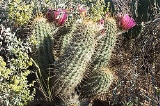
Echinocereus
Encyclopedia
Echinocereus is a genus
of ribbed, usually small to medium-sized cylindrical cacti
, comprising about 70 species
from the southern United States
and Mexico
in very sunny rocky places. Usually the flower
s are large and the fruit
edible.
The name comes from the Ancient Greek
ἐχῖνος (echinos), meaning "hedgehog," and the Latin
cereus meaning "candle." They are sometimes known as hedgehog cacti
, a term also used for the Pediocactus
and Echinopsis
.
In the wild, several of the species are cold-hardy, tolerating temperatures as low as -23°C but only in dry conditions. Sometimes, they shrink in winter but they look fine again with first waterings in the first sunny days.
Genus
In biology, a genus is a low-level taxonomic rank used in the biological classification of living and fossil organisms, which is an example of definition by genus and differentia...
of ribbed, usually small to medium-sized cylindrical cacti
Cactus
A cactus is a member of the plant family Cactaceae. Their distinctive appearance is a result of adaptations to conserve water in dry and/or hot environments. In most species, the stem has evolved to become photosynthetic and succulent, while the leaves have evolved into spines...
, comprising about 70 species
Species
In biology, a species is one of the basic units of biological classification and a taxonomic rank. A species is often defined as a group of organisms capable of interbreeding and producing fertile offspring. While in many cases this definition is adequate, more precise or differing measures are...
from the southern United States
United States
The United States of America is a federal constitutional republic comprising fifty states and a federal district...
and Mexico
Mexico
The United Mexican States , commonly known as Mexico , is a federal constitutional republic in North America. It is bordered on the north by the United States; on the south and west by the Pacific Ocean; on the southeast by Guatemala, Belize, and the Caribbean Sea; and on the east by the Gulf of...
in very sunny rocky places. Usually the flower
Flower
A flower, sometimes known as a bloom or blossom, is the reproductive structure found in flowering plants . The biological function of a flower is to effect reproduction, usually by providing a mechanism for the union of sperm with eggs...
s are large and the fruit
Fruit
In broad terms, a fruit is a structure of a plant that contains its seeds.The term has different meanings dependent on context. In non-technical usage, such as food preparation, fruit normally means the fleshy seed-associated structures of certain plants that are sweet and edible in the raw state,...
edible.
The name comes from the Ancient Greek
Ancient Greek
Ancient Greek is the stage of the Greek language in the periods spanning the times c. 9th–6th centuries BC, , c. 5th–4th centuries BC , and the c. 3rd century BC – 6th century AD of ancient Greece and the ancient world; being predated in the 2nd millennium BC by Mycenaean Greek...
ἐχῖνος (echinos), meaning "hedgehog," and the Latin
Latin
Latin is an Italic language originally spoken in Latium and Ancient Rome. It, along with most European languages, is a descendant of the ancient Proto-Indo-European language. Although it is considered a dead language, a number of scholars and members of the Christian clergy speak it fluently, and...
cereus meaning "candle." They are sometimes known as hedgehog cacti
Hedgehog cactus
The name hedgehog cactus can be applied to plants from any of the following three genera of cacti:*Pediocactus, 6-11 species*Echinocereus, 70 species of southern United States and Mexico. Ribbed small to medium and cylindrical cacti. Found in very sunny rocky places.*Echinopsis, 128 species of...
, a term also used for the Pediocactus
Pediocactus
Pediocactus is a genus of cacti. The genus comprises between 6 and 11 species, depending upon the authority...
and Echinopsis
Echinopsis
Echinopsis is a large genus of cacti native to South America, sometimes known as hedgehog cacti, sea-urchin cactus or Easter lily cactus. One small species, E. chamaecereus, is known as the peanut cactus. The 128 species range from large and treelike types to small globose cacti...
.
Description
Echinocerus are bushy and globular with tight spines which are often colorful and decorative. The flowers last slightly longer than other those of other cacti.Cultivation
Echinocereus is easier to culture than other cacti. They need a light soil, a sunny exposure, a fresh and dry winter to flower. They like a soil slightly richer than other cacti.In the wild, several of the species are cold-hardy, tolerating temperatures as low as -23°C but only in dry conditions. Sometimes, they shrink in winter but they look fine again with first waterings in the first sunny days.
Species
Formerly placed here
- Echinopsis candicans (Gillies ex Salm-Dyck) F.A.C.Weber ex D.R.Hunt (as E. candicans (Gillies ex Salm-Dyck) Rümpler)

